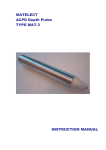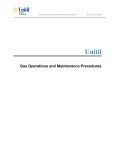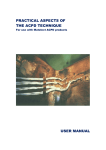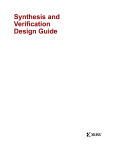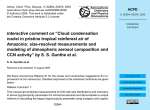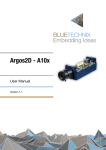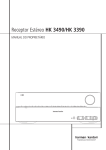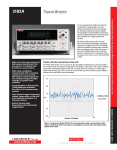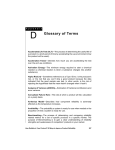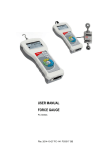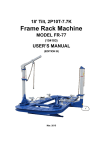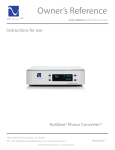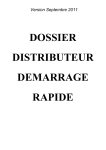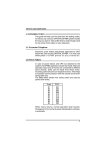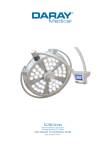Download matelect pulsed direct current crack growth monitor
Transcript
MATELECT DCPD Crack Growth Monitor TYPE DCM-1 INSTRUCTION MANUAL Matelect DCM-1 Instruction Manual 2 Matelect DCM-1 Instruction Manual MATELECT PULSED DIRECT CURRENT CRACK GROWTH MONITOR TYPE DCM-1 and DCM-1I Thank you for your interest in our product, we hope that it will serve your needs and prove a reliable tool. This product has been designed to the highest standard in both electronic and mechanical design, with careful attention to stability, reliability and electrical safety. The DCM-1 is an advanced DCPD crack growth monitor that utilises the pulsed direct current technique to monitor the propagation of cracks within metal specimens undergoing mechanical testing. Its microprocessor based design and pulsed current facility have resulted in a compact and lightweight DC system for use in the laboratory. The DCM-1I is a fully floating version of the DCM-1. Matelect manufacture the DCM-1 and are pleased to offer applications advice on the DCPD technique. The DCM-1 complements Matelect's existing range of ACPD equipment which is traditionally used where greater sensitivity to crack initiation and propagation is required. Please contact us should you ever require further information or assistance. IMPORTANT Please read these instructions carefully before you use the instrument. Please pay particular attention to the section that follows on mains operation. For your reference please also read our terms and conditions of sale printed at the rear of this manual. Use only a slightly dampened cloth and mild detergent to clean the DCM system. Never use a solvent cleaner or any fluid. Please note that there are no user serviceable parts within the DCM-1. Never attempt to open the instrument case as this will void any warranty. Please contact Matelect should you ever experience any difficulties. MATELECT LIMITED 7 Park Place, Newdigate Rd, Harefield, UB9 6EJ UK Telephone +44 (0)1895 823334 Facsimile +44 (0)1895 824300 E-mail: [email protected] 3 Matelect DCM-1 Instruction Manual 2. MAINS OPERATION This section applies to all mains operated instruments PLEASE READ BEFORE OPERATION Before use, please make sure that the instrument's supply rating is correct for the location it will be used in. The DCM-1 can be operated on both 100-110 and 220240V, 50/60 Hz mains supplies by appropriate selection on the input voltage switch (see page 12). Before shipment your instrument will have been set for the commonly used voltage in your locality. The instrument must be connected to the mains supply using an IEC mains lead terminated with the appropriate local mains plug. The unit is supplied with a suitable lead for this purpose. When pulsing the specimen current, the instrument will draw substantial currents through the mains cabling. If cables, extensions cords or supply lines of insufficient capacity are utilised, then undesirable mains voltage drops may occur during pulsing. Where the local mains supply is near the bottom limit of the DCM-1 operating range, such drops could cause the brightness of the LCD graphics display to dim in synchrony with the current pulse and the pitch of the operating fan to change. Do not operate the DCM-1 in these conditions - restore the supply's capacity by uprating the cabling. The instrument is housed in a metal case for strength and electromagnetic screening purposes and therefore PLEASE ENSURE that the instrument is earthed to the mains earth via the IEC connector. In addition to the fuse that may be present in the mains plug (e.g. UK versions), the DCM-1 is fitted with an equipment fuse for protection. This fuse is located in the IEC input socket on the rear panel of the DCM-1. This fuse must be functional if the equipment is to be operated. The instrument fuse is rated at 2.5 amperes and is of the 20mm "anti surge" type. Never replace this with a fuse of a different type or rating as the instrument can be seriously damaged. Ensure that the DCM-1 does not come into contact with fluids or corrosive gases and that it is operated within the temperature range of 0 - 40°C. 4 Matelect DCM-1 Instruction Manual 3. CONTENTS 1. Welcome ..................................................................................3 2. Mains Operation.....................................................................4 3. Contents ..................................................................................5 4. Overview .................................................................................6 5. General Description ...............................................................8 6. Front Panel Description.......................................................11 7. Rear Panel Description ........................................................14 8. DCM-1 Preamplifier unit ....................................................17 9. Connections to the specimen ...............................................19 10. Connection to a testing machine .........................................22 11 Setting up a test ....................................................................26 12. General usage advice ...........................................................29 13. Specifications ........................................................................33 14. Warranty Information.........................................................35 5 Matelect DCM-1 Instruction Manual 4. OVERVIEW The Matelect DCM-1 system has been designed to allow measurement of crack growth in metals using the pulsed direct current technique. The DCM-1 has been produced to replace the ageing DC systems that are common in laboratories throughout the world, with a modern, sophisticated yet easy to use instrument. The unit is microprocessor based and all functions are controllable from five front panel push buttons. The functions selected and the measurement values are displayed on a graphics LCD screen. In DCPD work, crack growth is measured by simply passing a constant direct current through the test specimen and measuring the voltage drop developed across an area of that specimen. The DCM-1 both sources the constant current and amplifies the minute voltages generated across the specimen. In effect, DCPD measures specimen resistance. As a crack propagates the specimen resistance will increase in a way that can normally be related to actual values of the crack depth. The currents that are required in DCPD, in order to obtain a measurable voltage, are of the order of tens of amperes. This requirement has made traditional DCPD systems large and bulky. Additionally DCPD suffers from problems due to the generation of thermoelectric EMFs which are of a similar magnitude to the true DCPD signals. The disadvantages that traditional DCPD suffers from have largely been eliminated by the use of a pulsed DC measurement method. Here, the current supply to the specimen is interrupted and pulses of current are passed, instead of a continuous flow. Measurements are taken both during and in between pulses. These are then compared in order to reduce noise and remove thermoelectric effects. For sensitive work, carefully designed voltage amplifiers are required. These need to be highly stable and as immune to noise as possible. A separate preamplifier greatly reduces the effect of noise that would otherwise originate from long signal leads. With careful design, impressive crack growth resolutions of a few tens of microns or better are possible. Temperature can markedly alter the characteristics of such voltage amplifiers. It is therefore important to make them as temperature insensitive as possible. Some amplifier designs incorporate heaters in order to maintain a constant temperature and hence reduce the drift, however, the advent of modern electronic techniques have made this unnecessary. This results in a simpler and more reliable measurement system. 6 Matelect DCM-1 Instruction Manual A further enhancement of the DCPD technique is to use two specimens. One of these is used as the test specimen, whilst the other is used as a reference so that changes in the DCPD due to environmental changes (e.g. temperature) are eliminated. The specimens are connected in series so that the same current flows through both. Two voltage measurement channels are required in this case. This technique is known as normalisation. Two channel normalisation can still be performed on a single specimen by using specialist formulae (available in published scientific literature). In such cases it is usual for the reference channel to be sited in an area that is not subject to cracking, although formulae have been developed to handle two channels, both of which straddle the crack site. Matelect can advise on some of these methods. The DCM-1 utilises the pulsed DC technique and can source current pulses of up to 50 amperes. All the functions are controlled via 5 front panel push buttons and a backlit LCD graphics screen. The DCM-1 is microprocessor based and consists of the main unit and a separate pre-amplifier unit that is placed close to the test specimen. The preamplifier is not heated and consists of two highly stable amplifiers for full two channel operation. The DCM-1I is a variant of the DCM-1 and contains a fully floating current supply and two fully isolated signal inputs. Isolation of this kind may assist users who wish to perform simultaneous electrochemical studies. This manual applies to the DCM-1 and DCM-1I pulsed DCPD units and preamplifiers. Users who experience any difficulty in operation of the equipment are advised to contact Matelect at the address given at the beginning of this manual. Items pertaining to the DCM-1I are highlighted in grey. 7 Matelect DCM-1 Instruction Manual 5. GENERAL DESCRIPTION The DCM-1 system comprises the following components; The main display and control unit The two channel pre-amplifier. Connection cables. The main display and control unit comprises the current sourcing and voltage measurement facilities and the graphics display screen. All functions are controlled by an internal Z8 microprocessor. In addition to measuring and displaying the DCPD readings, the main unit also performs a normalisation calculation if the user has selected two channel operation. Analogue outputs are provided at the rear of the DCM-1 so that the values of either the specimen channel, the reference channel and the normalised DCPD value can be recorded via a computer (suitably equipped with an analogue to digital converter card) or a chart recorder. The current is pulsed either automatically via an internal clock control or it can be pulsed by an external signal, sourced from the user's testing machine (or other equipment as appropriate). This facility allows the current pulses to be synchronised to a fatigue testing cycle. Such synchronisation is useful in order to measure the DCPD at a particular point on the testing cycle since the DCPD can often change during any one particular cycle. Changes due to crack closure, for example, can be followed by this method. The DCM-1 permits external synchronisation on both the peak and trough of the fatigue cycle (peak tension or peak compression). Additionally synchronisation to the zero load (cross over) point is also possible. Please see the section on Connections to the Testing Machine for further details. A pulse divider facility is also provided. This allows the current to be pulsed at integer values of the testing machine waveform. This minimises the current-on time and hence reduces specimen heating. It is also useful to reduce electrochemical effects. All current and signal gain (amplification) levels together with the pulse synchronisation options are set using a menu system that is displayed on the front panel graphics screen. The menu system is simple to operate and requires little explanation. To assist the user, however, this manual gives an example of how to set up a typical test regime. 8 Matelect DCM-1 Instruction Manual The separate preamplifier unit has inputs for two channels and should be sited as near to the specimen as possible. It incorporates high stability, low drift amplification circuitry which conditions the minute DCPD voltages and supplies them in amplified form to the main unit. The main unit digitises the incoming DC signals from the preamplifier and displays them on the graphics screen. In general, the DCPD system should be configured as shown in Fig.1. All the required cables for this set-up are provided with the DCM-1 and these are illustrated overleaf in Fig 2. In the example shown, two specimens are used, one as the test piece and the second as a reference. It is usually advisable to use a reference test piece in DCPD studies, although other configurations are possible. Further operational advice is given throughout this manual and detailed topics are covered in the section entitled, General Usage Advice. Main Unit with display X/Y analogue output X analogue output TO PC OR CHART RECORDER Machine cycle input current outputs FROM TESTING MACHINE pre-amplifier screened signal cables High capacity connecting cables specimen reference Fig 1. General schematic view of a typical DCM system set-up 9 Matelect DCM-1 Instruction Manual Test machine cycle (BNC) to DCM-1 cycle input X/Y or X output (BNC) to chart recorder or acquisition system preamplifier output to DCM-1 preamplifier input preamplifier X input to specimen preamplifier Y input to specimen specimen to reference current lead specimen to positive DCM-1 current terminal reference to negative DCM-1 current terminal IEC Mains input (IU-1) to Local mains plug Fig 2. Cables supplied with the DCM-1 system 10 Matelect DCM-1 Instruction Manual 6. FRONT PANEL DESCRIPTION The front panel of the DCM-1 is shown in Fig 3. The controls are simple to understand and all test parameters are set using the five front panel push buttons. MACHINE CYCLE IN MATELECT Please select variable to adjust Set current Set measurement point Set measurement frequency Set X and Y gains Set filter time constants Run/Stop ON MATELECT DCM-1 2 CHANNEL PULSED DCPD SYSTEM SELECT FUNCTION SELECT PREAMPLIFIER INPUT CURRENT ON Fig 3. The front panel of the DCM-1 main unit 1. Graphics Display This is a high resolution LCD graphics panel with a cold cathode fluorescent backlight. Like all LCD displays, the contrast seen by the observer is viewing angle dependant and therefore the contents of the display may not be visible from all angles. The contrast has been factory set to provide the best compromise between visibility and viewing angle. The display determines the active operating temperature range of the DCM since too high an ambient temperature will cause the screen to darken. Too low a temperature will result in a slow response to changes in the displayed characters. In both cases the display will return to normal when the ambient temperature is within an operating range of 10 to 35 degrees Celsius. NOTE: The LCD panel is sturdy but should only be cleaned with a slightly moistened cloth. Do not use a chemical cleaner or damage to the display surface will occur. Do not press down on the display area and never use a sharp instrument such as a pen to tap or poke the surface. 11 Matelect DCM-1 Instruction Manual 2. Selector push buttons. Menu options are selected and chosen by use of these push buttons. Additionally the keys are used to increment or decrement experimental parameters such as the value of the applied specimen current or signal gain. The four black buttons are cursor keys which control the movement of the display cursor and increment or decrement values. The direction of cursor movement is indicated by the arrow legend positioned alongside each button. The central red push button is used to activate a particular option once this has been selected by the cursor keys. The red button acts as an "enter" key. The keys are pressed and released once to move by one position or to alter a value by the minimum increment. There is no repeat function on each key, so successive key presses are required to further alter a value or position. Numerical parameters are not altered on a cyclical basis on every menu option. This means, for example that once a maximum value has been selected for a parameter or digit, further changes are only possible by using the decrementing push button. 3. Machine cycle input socket This is a four pin, polarised female socket which accepts a waveform signal from an external source, usually the testing machine, and permits synchronisation of the current pulses supplied by the DCM-1 to the input signal. A cable is provided for connection between this socket and the testing machine. The input waveform needs to be within certain specified limits of both frequency and amplitude in order to allow reliable synchronisation. The pin configuration of this connector is given, together with further details on the input signal range in the section on Connections to the Testing Machine. NB. When connecting the supplied cable to this connector, locate the protrusions on the cable mounted socket with those on the connector. The plug should then enter the socket. Only then should the screw collar be tightened onto the socket. 4. Preamplifier In socket. This is a twelve pin polarised female socket that connects via the cable supplied to the rear of the DCM-1 preamplifier box. NB. When connecting the supplied cable to this connector, locate the protrusions on the cable mounted socket with those on the connector. The plug should then enter the socket easily. To remove the plug, simply grasp the sliding collar and pull. 12 Matelect DCM-1 Instruction Manual 5. ON indicator. This consists of a red LED which lights to indicate that power has been applied to the DCM-1. If this indicator remains off after external power has been applied, turn off the mains supply then READ the section on Mains Operation at the start of this manual Check that the mains cable has been fully pushed into the rear panel IEC mains input socket and that your mains supply is available (use another appliance which you know is functional in order to test that the mains supply is present). If these are in order, check the fuses both in the instrument's IEC connector and in your mains plug (if a fuse is fitted). Contact Matelect if none of these checks provides a solution. 6. Current On indicator This green LED flashes in unison with the current pulse as supplied to the test specimen. It remains off during the periods when the specimen current is off. Because of internal limiting circuitry, the current pulses can never be closer than about 700mSec apart. The indicator should, therefore, never pulse at frequencies greater than this even when external control waveforms of greater than 1 Hz are applied. 13 Matelect DCM-1 Instruction Manual 7. REAR PANEL DESCRIPTION The rear panel of the DCM-1 is shown below in Fig 4. Located on this panel are the mains input socket, analogue and RS232 outputs, voltage selector, auxiliary and current supply outputs. A heatsink is also positioned on this panel together with its cooling fans. The air vents at either side of the heatsink and the air vent along the bottom edge of the rear panel should never be obstructed. Failure to adhere to this can cause serious damage to the DCM-1. If the fan units fail to operate, the DCM-1 should not be used. Please contact Matelect in the unlikely event of this ever happening. SER. X Y X/Y COMMON EARTH CURRENT OUT AUX. VOLTAGE SELECTOR Fig 4. Schematic of the DCM-1 main unit rear panel 1. Mains input socket. This is a standard IEC mains input socket with integral line filter, mains switch and mains fuse. A suitable lead, terminated with a local mains plug, will have been supplied with the DCM-1. If this is missing, only use an approved mains connector lead in the IEC socket. The instrument is fused with a 2.5 ampere quick blow 20mm fuse. If this fails for whatever reason, disconnect the equipment from the mains supply and replace the fuse with one of the same rating and type. DO NOT use a fuse of a higher rating as permanent damage may result to the DCM-1. If the local mains plug also incorporates a fuse, then this should be of a similar rating to the fuse within the IEC socket. 14 Matelect DCM-1 Instruction Manual 2. Serial Data (RS232) output socket. This is a 9 way D type male socket. The pins are configured as a standard RS232 9 way connector. The data format and pin out details can be obtained from Matelect. Software for data acquisition via the serial data link is available from Matelect. 3. Analogue Outputs. The DCM-1 provides three analogue outputs of the measured DCPD values. These are available as analogue voltages on the three BNC connectors marked X, Y and X/Y. The X and Y outputs will ideally be in the range from 0 to 2 Volts, although approximately 3 volts is the maximum possible. These outputs correspond exactly to those shown for the X and Y channels on the front panel graphics display. The X channel should be connected to the test specimen and the Y channel to a reference specimen. If a reference signal is being employed, then the user should monitor the X/Y output which exactly follows the value of the X/Y ratio shown on the graphics screen. This voltage can range from 0 to about 10 Volts. All outputs are buffered and are suitable for connection to a chart recorder or computer data acquisition system. A chart recorder cable is supplied with the DCM1. If any other cable is used, please ensure that the correct polarity is maintained - the Common of the output is always the outer portion of the BNC connector. 4. Common and Earth Terminals. The circuit common of the DCM-1 is electrically isolated from the case Earth. If it is desired to connect the common to earth, a wire link can be used between the Common and Earth terminals. Isolation of the Common is useful if external peripherals are connected to the DCM-1 such as chart recorders. If their signal common is connected to Earth, an Earth loop could occur, should the DCM-1's common also be connected to Earth. Such loops are sources of signal instability and should therefore be avoided. 5. Current output terminals. These screw action terminals are coloured Black and Red. For a DCM-1 Red is actually circuit common and the Black is circuit negative, however, this is of no consequence to the user who should adhere to the colour code rule as given in the section entitled Connections to your Specimen. For a DCM-1I, the current terminals are fully isolated from the Common of the main circuitry. 15 Matelect DCM-1 Instruction Manual The appropriate cables (supplied) should be used between these terminals and the specimen/reference. It is advisable to attach the cables and specimen to the current terminals before attempting to supply a current. Making a connection to the supply whilst the DCM-1 is pulsing a current will cause sparking at the point of connection. This is not good practice since sparks are sources of electrical noise which can often upset sensitive electronic equipment. If the current connections are not properly made an error message will appear on the front panel graphics display to alert the user as soon as an attempt is made to source a current. This will also occur if the resistance of the specimen-cables-DCM-1 circuit is high enough to cause the voltage compliance of the current source to be exceeded. If the compliance limit is exceeded, check the current connections and reduce the value of the set current if necessary. In certain circumstances, highly inductive specimens or cable set-ups can cause the compliance error message to appear. Altering the positions of the current leads may solve this problem. 6. Auxiliary power socket. This socket is used to power peripheral instrumentation that can be connected to the DCM-1, for example, a signal multiplexing system. The socket is wired as follows; Pin 1 Positive 17 volts unregulated, 100mA maximum (right hand) Pin 2 Circuit common Pin 3 Negative 17 volts unregulated, 100mA maximum (left hand) The supplies are fused and current limited to prevent damage to the DCM-1 should a short circuit occur. Only Matelect approved apparatus should be connected to this socket. 7. Voltage selector switch. PLEASE READ THE SECTION ON MAINS OPERATION at the beginning of this manual before attempting to alter the position of this switch. The switch permits the DCM-1 to be used with either 110-120 or 220-240 mains supplies. The DCM-1 is factory adjusted to the correct mains input voltage before shipment but users may wish to alter this depending on the location of the instrument. A wide blade screwdriver should be inserted into the slot within the switch and rotated to the appropriate input voltage (as marked on the switch). CARE! Operation of the DCM-1 with this switch incorrectly positioned will cause serious permanent damage to the unit. When altering the switch position ENSURE that the mains supply is disconnected from the DCM-1. 16 Matelect DCM-1 Instruction Manual 8. DCM-1 PREAMPLIFIER UNIT Fig 5. shows the front and rear panel views of the separate DCM-1 pre-amplifier. The connectors on these panels will mate with the appropriate cables supplied by Matelect. Should it be necessary to lengthen the cables, please contact Matelect for further advice. The pin configurations for each of the signal input connectors are given in Fig 6. Users should note that Matelect can accept no responsibility for damage caused by incorrect cabling or connections. NB. When connecting the supplied cables to the connectors, locate the protrusions on each cable mounted socket with those on the mating connector. The plug should then enter the socket. Only then should the screw collar be tightened onto the socket (for the signal inputs). The system unit output cable is terminated a push/pull locking connector. MATELECT LIMITED INPUT X INPUT Y Front panel of preamp DCPD Preamp Output to system unit Rear panel of preamp Fig 5. Schematics of Preamplifier front and rear panels 17 Matelect DCM-1 Instruction Manual LARGE LOCATING LUG 2 1 4 3 1. X/Y SIGNAL POSITIVE (red on cable) 2. Not connected 3. X/Y SIGNAL NEGATIVE (black on cable) 4. Circuit common (not earth) (screen on cable) CHANNEL X and CHANNEL Y input sockets on preamplifier front panel Fig 6. The pin configuration of the X and Y input sockets located on the preamplifier The DCM-1I contains isolated signal inputs which are fully floating with respect to the circuit Common of the main instrument. Isolation is performed by a voltage to frequency converter, feeding a frequency to voltage converter through an optocoupler The pre-amplifier should be mounted close to the specimen to minimise noise and it should not be subjected to temperature gradients across its external dimensions. Further details on these points are given in the following section. 18 Matelect DCM-1 Instruction Manual 9. CONNECTIONS TO THE SPECIMEN GENERAL In general, if no specific test regime has been chosen by the user, the configuration shown in Fig 1, should be employed. Two specimens are utilised, one acting as the test specimen and one acting as the reference specimen. A reference specimen is used to counter any thermal effects that occur due to a variation in the ambient temperature. The value of the DCPD from the test specimen is normalised via a division using the DCPD value from the reference specimen. This method will only work if both the test and reference specimens are subjected to the same ambient temperature and also that any temperature variations are uniform in nature. For example, bright sunlight shining only on one side of the test or reference specimen can seriously affect the DCPD values obtained. CONNECTIONS Users must obey the usual sign conventions when connecting the current and signal cables to the test and reference specimens. The signal-high wire on the signal cable (coloured red) should always be connected to the side of the specimen nearest the Red current terminal. The signal-low (black) wires should similarly be situated nearest the connection to the black current terminals (see Fig 1). If the colour code is not followed, an error message will appear on the front panel graphics display alerting the user, once current has been supplied to the test pieces. Users should always employ the standard cables as supplied by Matelect with the DCM-1 system. If the cables have had to be lengthened, please ensure that the same type of cables are used and that the connections to the DCM-1 are made correctly. Unfortunately Matelect cannot accept responsibility for any damage caused to the DCM-1 by incorrect cable connections. If a lower rating of current cable is utilised (below ca. 70 amperes continuous) users may find that the voltage compliance of the current source is reached well before it is possible to pass the maximum current. This may especially be applicable for large or high resistivity specimens. 19 Matelect DCM-1 Instruction Manual CONTACTS Securing the current cables to the specimen is best accomplished using a large gauge threaded fastener, such as a machine screw. Ensure that the contact surfaces are free from corrosion and any poorly or non-conducting surface layers, as these can also force a lower maximum current by causing the voltage compliance to be reached. The signal contacts can be made using finer screw fasteners or they can be spot welded. Other methods such as conductive glues or soldering can be used for specialist applications. For test specimens that are to be submerged in an electrolyte (e.g. water) it is important to use fastening materials and methods that are electrochemical compatible. Corrosion of the current contacts can be especially problematic in DCPD studies but the use of pulsed current as opposed to continuous, has reduced these effects dramatically. THERMOELECTRIC EMFs Thermoelectric EMFs are generated wherever dissimilar metals are in contact with each other. These can be of the same order of magnitude as the value of the actual DC signals due to the specimen resistance. Such EMFs can therefore destroy the integrity of DCPD results. Again the use of pulsed currents has effectively eliminated the thermoelectric effects. Pulsing allows the EMFs to be measured during the current OFF period. The OFF reading is subtracted from the ON reading thus eliminating the thermoelectric EMFs. This method assumes that no temperature change occurs between the two sets of readings. This is a fair assumption unless abnormally high rates of heating or cooling are occurring. NOISE All cables leading from the specimens to the pre-amplifier should be shielded from stray EM radiation and as short as practicable. Remember that the voltage resolution at the specimen surface ranges from a few hundred nanovolts to a few tens of nanovolts (dependent upon gain) so any noise can seriously affect the integrity of the measurements. OTHER CONSIDERATIONS The preamplifier should be sited close to the specimen. The preamplifier should not be subjected to uneven heating of its enclosure as this can cause errors in the measured DCPD. A general change in ambient temperature does not pose a problem as the thermal drift of the pre-amplifier circuitry is extremely low. 20 Matelect DCM-1 Instruction Manual Unlike ACPD, DCPD specimens should be electrically isolated from the test machine. A significant portion of the DC current will flow through the testing machine to earth if this rule is not followed. Damage to equipment is unlikely to occur but the voltage readings obtained under such a situation will be worthless. Additionally any alternative current paths may not exhibit a constant resistance during a test, so specimens must be always be electrically isolated. Most users have their own method of specimen isolation but in general, any thin strips of paper or adhesive tape can be used to insulate the specimen surface from the testing machine grips. In the case of standard CT specimens for example, the pins that permit the specimen to be stressed must also be isolated from the specimen. Conventional pins are usually machined to be a tight fit into the specimen locating holes so as to minimise "slack". Smaller pins will therefore have to be machined in order to permit insertion of an isolating layer. 21 Matelect DCM-1 Instruction Manual 10. CONNECTION TO A TESTING MACHINE PULSE SYNCHRONISATION For fatigue studies, the pulses of current as supplied by the DCM-1 can be synchronised to an external waveform source. This waveform is usually derived from the user's testing machine. Since the DCPD values are measured during a current pulse, the synchronisation facility permits the acquisition of DCPD values at particular points on the load or displacement cycle. This facility can, for example, be used to investigate crack closure phenomenon. A cable is supplied to enable users to connect the DCM-1 to a testing machine's cyclical output. The waveform is usually available on the testing machine as a buffered BNC output of either the load or displacement values. These are analogue voltages usually scaled according to the load cell amplitudes chosen by the testing machine user. The following diagram illustrates the connections to the input socket on the front panel of the DCM-1 main unit. Large locating lug on socket 2 1 4 3 1. Signal low (BNC outer) 2. +15V supply (for peripherals) 3. Signal high (BNC centre pin) 4. -15V supply (for peripherals) Machine Input socket on front panel of the DCM-1 main unit Fig 7. Testing machine input socket pin configuration It is important to note that the synchronisation circuitry is not capable of following all types of input signal, over all values of input amplitude and frequency. The limits are given overleaf. Should your input signal fall outside the range, reliable synchronisation may not be possible. Matelect may be able to assist users with specific synchronisation needs but this will usually require non-standard modifications to the existing circuitry. 22 Matelect DCM-1 Instruction Manual Your test machine manufacturer should be contacted for further advice on the provision and location of a suitable waveform output. The input ranges have been chosen to match closely the likely amplitudes and frequencies normally employed by testing machine users. If your settings are not within this range you should consider using the internal pulse generator facility of the DCM-1. SIGNAL INPUT RANGES For reliable operation, the synchronisation circuitry requires: 1. A signal amplitude of (+10 volts to -10 volts) maximum 2. A signal amplitude of (+2 volts to -2 volts) minimum 3. A maximum signal frequency of 10 Hz 4. A minimum signal frequency of 0.1Hz 5. A sinusoidal or triangular wave signal Signals not within this specification may still permit synchronisation but the reliability will degrade with a divergence from these limits. POINTS TO NOTE Synchronisation can be set to occur on the peak, trough or zero crossing portions of the input waveform. The DCM-1 does not have to pulse at each synchronisation event since a pulse divider facility is provided whereby the user can set pulse intervals of between 1 and 9999 cycles. Signals with a DC offset, e.g. -2.5 to +7.5 volts (equivalent to a 2.5 volt offset) can still be synchronised to - providing the offset does not cause the signal to range above the +/- 10 volts maximum and that either Peak or Trough mode is selected. In the Zero Cross Over mode, synchronisation will only occur if the waveform actually crosses zero. DC offsets are therefore tolerated provided they do not cause the whole waveform to become either positive or negative in polarity. Once again overall signal amplitudes should not exceed the limits given above. The machine cycle input is voltage and current protected to 50 V continuous or 250 V intermittent but users are advised not to test these limits! The current source within the DCM-1 is not permitted to pulse faster than approximately 1.5 Hz. However, the synchronisation circuitry can still accommodate waveform signals up to 10 Hz in frequency. For such signals, synchronisation will still take place at the peak, trough or zero point, except that it will occur after the passage of the appropriate number of waveform cycles commensurate with the 1.5 Hz limitation. Some of these points are illustrated in the schematic overleaf. 23 Matelect DCM-1 Instruction Manual TEST MACHINE WAVEFORM CURRENT PULSES SYNCHRONISED TO PEAK TENSION CURRENT PULSES SYNCHRONISED TO PEAK COMPRESSION CURRENT PULSES SYNCHRONISED TO ZERO CROSSING CURRENT PULSES SYNCHRONISED TO HIGH CYCLE PEAK TENSION Fig 8. Waveform synchronisation examples Synchronisation to waveform frequencies down to 0.01 Hz is possible providing that the signal amplitude is raised above +/- 8 volts. However at such low frequencies there is little point in using synchronisation as the amount of data collected will be quite small. It therefore may be better to use the internal pulse generator and log the maximum number of data points available. 24 Matelect DCM-1 Instruction Manual The load and displacement outputs from most testing machines are scaled according to the following criteria: 1. 2. The range chosen for a particular load cell The percentage amplitude within the chosen range of the fatigue cycle. For example, a 100kN load cell might be used on one of 4 load ranges, 10, 20, 50 and 100kN. Within each range it is possible to apply loads of zero to 100% of the range with negative loads (compression) also allowed. The maximum analogue output on any range is usually 10 volts and this corresponds to 100% of the particular range. Thus on a 20 kN range, operating at +/-50% load capacity, the load would range from +/-10kN and the analogue output would range between +/- 5 volts. This example indicates that for reliable synchronisation, the load (or displacement) should never be below 20% of its range (for a +/-10 Volt testing machine) and ideally it should correspond to 7.5 volts or 75%. For values below 20% a separate signal amplification unit (type LCC-1) can be used to boost the signal levels before they enter the DCM-1. Please contact Matelect for further details. ANALOGUE SIGNAL INPUT Some way of recording the DCPD is usually required by the user. It is not practical to take readings from the front panel display although still perfectly possible. Analogue voltage outputs are therefore provided on the rear panel of the DCM-1 main unit and these can be connected to a chart recorder to provide a continuous and permanent record of the DCPD values. It is also possible to digitise these signals using an analogue to digital converter card fitted into a personal computer. In this way the data can be stored for later retrieval and processing. Many of the newer testing machines incorporate advanced digital functions which often include the provision of auxiliary inputs to internal A-D converters. The analogue voltage from the DCM-1 can thus be easily input into the testing machine, stored and displayed against and together with various other parameters. Please contact your testing machine manufacture for advice on such facilities. 25 Matelect DCM-1 Instruction Manual 11. SETTING UP A TEST Please read all the previous sections within this manual before commencing to set up a test. The simplicity of operation of the DCM-1 precludes the need for elaborate explanation of the setting up options. In this section, therefore, the various options available to the user are described with the aid of a standard set-up routine. Once experienced in the operation of the DCM-1, users are not required to rigorously follow the following set-up. Indeed with experience, the DCM-1 user will wish to use his or her own set-up parameters which have been optimised for a particular specimen or test. Providing the precautions and recommendations already described in this manual have been followed, no damage can be done to the DCM-1 by a non-standard combination of menu options, so the user should feel free to experiment with the parameters in order to achieve an optimum test result. A BASIC FATIGUE TEST USING THE DCM-1 This example describes a fatigue test set-up, with current pulse synchronisation and a reference specimen. It is designed as an illustration of the options available and should not be considered a full and exhaustive description of the procedures involved in such a test. 1. If possible, perform a set-up test with the specimens not attached to the testing machine as follows. 2. Connect the system components as shown in Fig 1. Remember to follow the colour code for the connections to the specimen. Use only Matelect cables where specified. Ensure all connections are firm and properly made. Connect the analogue outputs (in this case X/Y) to a chart recorder or acquisition system. 3. Connect the DCM-1 to the main power and activate it using the rear panel mains switch. The front panel display should light and after a short delay, the Main Menu will appear. Allow at least 30 minutes warm up time (see the section entitled Usage Advice). 4. Use the cursor keys to travel between each option and use the central red key to alter the option, input information or make a choice. Start at the beginning of the menu and work downwards. If, after setting all the values, a parameter has inadvertently not been set, the microprocessor will politely inform you of your error. At any time you can return to a menu option and change it without difficulty. 26 Matelect DCM-1 Instruction Manual 5. Set the test current. This can be set between zero and 50 amperes in steps of 10mA. For a typical CT specimen try 30 Amps. 6. Set the measurement point. If pulse synchronisation is required, set either peak tension or compression or zero load. If the test will be under constant load select N/A. For our example select peak tension. 7. Select measurement frequency. In our example select cyclic load. Select steady load if a simple load-extension test is being performed. A supplementary menu will ask you how often you wish to pulse the current and hence measure the DCPD values. Set 0001 for every cycle, set 0002 for every other cycle, 0003 for every third cycle etc. up to 9999 cycles. If a steady load had been chosen, the measurement frequency will be in seconds rather than in cycles. Try 0001. 8. Set the amplification value (gain) of the DCM-1 system. The gain can be varied between 1000 times and 50000 times in steps of 1000. See the following section for recommendations on the most suitable setting. As an example select 1000. 9. Select the filter time constant. This should always be set to 200mSec unless users wish to experiment with shorter periods. See the following section on Usage Advice for further details. 10. Begin the test. Use the Test Settings option to check the results of your set-up. Test Settings pulses the current at 1 second intervals through the specimen. Therefore you do not require a synchronisation waveform for this test. Any errors in the current or signal connections will now be indicated. 11. If the readings obtained on channel X and Y are each about 1 volt, then the current and gain settings are ideal. Please read the following section on Usage Advice for further details. 12. To stop the test, press and hold down the RED button until you are returned to the Main Menu. 13. Remove the DCPD connections if required and attach the specimen to the testing machine, and perform your usual test machine set-up. Ensure that the machine cycle input socket has been correctly connected to your testing machine output and that sensible values of the cyclic frequency and amplitude have been set (see section on Connections to Your Testing Machine). 14. Check the electrical isolation of the test specimen from the testing machine. Attach the current and signal cables to the specimen, locate the reference and preamplifier close to the specimen but away from sources of noise and uneven heat. 27 Matelect DCM-1 Instruction Manual 15. Commence the fatigue test, and the DCPD test (using the "Begin test using values set" option on the Run/Stop sub menu.) 16. The readings obtained should be similar to those observed during the set-up test. If they are not check the level of noise on the signal by observing the front panel readings (it should be about two digits maximum). Also check the integrity of the connections and the isolation of the specimen. Contact Matelect for further advice if a problem remains. Remember that to translate voltage or voltage ratio into crack depth, it is usual to perform a calibration test whereby the readings are related to the crack depth as measured by another technique. The following section on Usage Advice gives further details on calibration. 28 Matelect DCM-1 Instruction Manual 12. GENERAL USAGE ADVICE This section deals with some of the finer points relating to DCPD and the DCM-1 in particular. GAIN VERSUS CURRENT VERSUS NOISE In general the lower the gain setting of the DC amplifiers, the lower the observed noise. Therefore in order to obtain a respectable signal level, a high current may be required. Naturally the value of the current depends upon such parameters as specimen size and contact spacing. Users should aim to obtain a signal level of between 0.5 and 1 Volt for channels X and Y by appropriate adjustment of the current and gain. Whilst it is advisable to use the lowest appropriate value of the gain, users must note that high specimen currents can lead to specimen heating, especially around an advancing crack tip. In such circumstances a further variable can be brought into play - the pulse frequency. This can be adjusted by the user from within the Measurement frequency option of the Main Menu. To reduce specimen heating a long delay between pulses should be chosen. From the above example it is clear that several operating parameters are closely dependent upon each other and changing one will invariably affect the other. Only through experience can these variables be reconciled. NOISE AND RESOLUTION The noise on the readings is usually described in terms of the digit flicker. Naturally the flicker is greater, the higher the gain setting. The flicker should be +/- 1 digit at a gain of 1000, rising to +/- 3 digits at gains in excess of 30,000. The small change in noise with gain illustrates the excellent noise specification of the pre-amplifiers. The noise levels are largely determined by what is termed pixel noise within the digital components of the DCM-1. Since the displayed voltage resolution is 1mV, the voltage resolution of the DCM-1, at the specimen, ranges from 1μV at a gain of 1000 to an impressive 20nV at a gain of 50,000. The noise figures quoted above correspond to voltage levels of 1μV to 60nV at the respective gains. Crack length resolution is determined by both the theoretical resolution and the noise specification. A typical static calibration test (see the section on Calibration) results in a change of voltage of around 50 digits (50mV) per millimetre. This equates to a theoretical resolution of 20 micrometres. In practice the noise specification would affect this value but nevertheless 50 micron resolution is readily achievable (ignoring external sources of noise). 29 Matelect DCM-1 Instruction Manual VOLTAGE READINGS Please note that the maximum displayable voltage reading on either channel X or Y is 3 volts, however signal saturation will occur at voltage levels above 2.5 volts. It is therefore advisable to question the integrity of any voltages above 2.5 volts. The X/Y value can, however, reach 10 volts with no saturation problem. The recommended starting voltage of between 0.5 to 1 Volt will usually ensure that a propagating defect will not exceed the 2.5 Volt maximum. X/Y CONSIDERATIONS Please remember that the maximum sensitivity of measurement is achievable when X and Y channels return a similar voltage level. If one or other of these values differs substantially from its partner, errors in the X/Y division can occur. Thus a low X value when divided by a much larger Y value will result in a small X/Y ratio. Any noise on the Y signal will cause a large change in the X/Y ratio. Similarly, a low Y value will result in a high X/Y ratio, and any noise on the X or Y signal will cause a large change in the X/Y output. Additionally, the X/Y ratio is limited to a maximum of about 12 volts by internal circuitry constraints. In general, therefore, maintain X and Y at similar levels so that X/Y remains approximately within the 0.5 to 1.5 range. Naturally, this may not always be possible, especially if the signal probe spacings are substantially different between the test and reference specimens. WARM UP CONSIDERATIONS Ideally, the DCM-1 should be allowed to warm up after switch on for 30 minutes to allow the electronics to thermally equilibrate. If the unit has been moved and was subjected to a large difference in temperature between localities, please allow a correspondingly longer warm up period. Once a specimen has been connected to the DCM-1 and the test has commenced, the actual process of passing a current through the specimen will inevitably cause a rise in the specimen temperature. Since DCPD basically involves the measurement of resistance, such a temperature rise will alter the measured X and Y values. In theory X/Y should remain constant assuming the temperature change affects both X and Y channels similarly. This may not always be a fair assumption as cooling rates may differ between specimens, depending on their locality. In addition, users must ensure that both the specimens and pre-amplifier unit are warmed evenly by the external ambient. Localised warming can dramatically alter DCPD results, both by the change in specimen resistivity and by the occurrence of thermoelectric EMFs. 30 Matelect DCM-1 Instruction Manual CALIBRATION CURVES The translation of voltage measurements into crack depths is usually performed via a calibration curve. Values of the voltage are plotted against crack depth as measured by some other technique such as optical observation. Unfortunately, unlike the linear relationship between crack depth and voltage present in ACPD studies, DCPD calibration curves are not normally linear and therefore many more test points are required in order to accurately define the calibration. Once again specimen geometry plays a significant role in the shape of the calibration curve. Various formulae and models have been produced by workers within the DCPD field to describe and predict the shape of the calibration curve. These models are usually confined to specific specimen geometries but their existence permits simpler calibrations. Most of these models are available in the published literature and Matelect are happy to provide applications advice on these matters. A simple calibration can be obtained by performing a saw cut experiment in which a progressively deeper slit is made in a test piece using a hacksaw or ideally, a rotary blade whose depth of cut can be precisely defined. Between each saw cut, the blade is removed and the voltage readings noted, together with the cut depth. A typical saw cut calibration is shown in Fig 9. Depth (saw cut) (mm) 12 10 8 6 4 2 0 1 1.1 1.2 1.3 1.4 1.5 1.6 X/Y Fig 9. A typical quick saw cut calibration curve 31 Matelect DCM-1 Instruction Manual FILTER SETTING It is strongly recommended that users always select the 200mSec filter position since values below this produce a degradation in the noise performance. MICROPROCESSOR CONSIDERATIONS The Z8 microprocessor that forms the heart of the DCM-1, like all computers can sometimes cease to function or "crash". Should this occur, the only option is to reset the DCM-1 using the mains switch. Allow 5 seconds before re-applying power to permit the voltage levels within the unit to decay. A crash is usually caused by unusually strong amounts of extraneous electrical noise. This can originate from nearby equipment, especially that which is switching or controlling large currents. The DCM-1 is housed in an earthed metal enclosure which acts as an effective Faraday cage and ensures a high immunity to extraneous noise. Both front and rear panels are part of the earthed cage. It is therefore imperative, both from a safety viewpoint and that of noise immunity, to ensure that the enclosure is earthed via the mains supply lead. Should your unit continually crash please contact Matelect for further advice. Extraneous noise may also seriously degrade the performance of the DCM-1. If the digit flicker observed on the X or Y channels is substantially greater than the noise figures quoted in this text, users should take steps to reduce the electrical noise in the locality. 32 Matelect DCM-1 Instruction Manual 13. SPECIFICATIONS GENERAL:Two channel (reference and specimen) PULSED DCPD unit, housed in a portable enclosure that can either be bench or rack mounted. Z8 microprocessor controlled main unit with separate DC pre-amplifier unit. Cold cathode fluorescent backlit super twist nematic LCD graphics panel, 240 x 128 pixels. ELECTRICAL SPECS. Current: Variable PULSED 0A to 50A in steps of 10mA No minimum load required Voltage compliance of 4.5V. Value is set by a front panel key pad, and indicated on a front panel backlit graphics LCD display. Current stability is 0.01% Noise on supply is below detection limits of the DC amplifiers. Fully isolated current supply (250V) for DCM-1I option Voltage Amplification Separate, non heated, dual pre-amplifier unit Two amplifiers are used per effective channel (X monitors crack site, Y monitors reference site) Gain setting via front panel keypad Total gains of 1000 to 50000 in steps of 1000, selectable with the amplified output displayed on the graphics LCD display. Front panel display of value of both X value, Y value and the ratio X/Y Noise (referred to input) is less than 500pV (pico) per root Hz or 500nV (nano) peak to peak over the measurement bandwidth or +/- 1 digit at a gain of 1000. Drift: less than 200nV (nano) per degree C Maximum resolution: 20nV (nano) Common mode rejection ratio (CMR) better than 120dB from DC to 100Hz. Fully isolated voltage inputs (both X and Y) for DCM-1I option ADDITIONAL FEATURES: 3 position Filter provided to further remove noise Filter selectable in OUT, 20mS or 200mS (milli) modes DCPD measurement synchronisation: Measurement of DCPD can be chosen to occur at the maximum, or minimum 33 Matelect DCM-1 Instruction Manual or cross-over positions of the load cycle waveform (either triangular or sine) of the testing machine. Synchronisation requires testing machine input. of (+/-)2-10V over frequency range 0.1 to 10 Hz with operation outside this range possible. Pulse divider: This allows current to be pulsed at multiples of the testing machine cycle. This minimises current ON time and hence reduces specimen heating associated with DC systems Pulse divider has variable period - up to one in every 9999 cycles. Analogue output of amplified DC signals. RS232 output of amplified signals and X/Y ratio. POWER: 220-240 or 110-120V AC input, 50 or 60 Hz line frequency by appropriate user selection. MAINS INPUT: Via Earthed IEC connector LINE FUSE: One 20mm 2500mA antisurge fuse fitted to rear IEC connector DIMENSIONS Without handle 360 x 310 x 155 mm (W x D x H) (main unit) 115 x 95 x 47 (pre-amplifier) MECHANICAL Cast aluminium frame with pressed aluminium alloy panels finished in standard RAL powder coat. Preamplifiers housed in extruded aluminium enclosure finished in epoxy powder coat Adjustable tilt handle (no cost option) OPERATING TEMPERATURE RANGE 0 - 40 Degrees Celsius for electronics 10-35 Degrees Celsius for graphics display MASS SEALING STANDARD 34 12Kg To IP20 Constructed in accordance with CEI/IEC 1010-1 1990 Matelect DCM-1 Instruction Manual 14. WARRANTY AND SERVICE INFORMATION The following text is an extract from our standard conditions of sale. It covers the terms of warranty and liability only. Please refer to the full text, supplied upon delivery of the goods or contact Matelect Limited. Extract 6. WARRANTYItems sold by the company are warranted only as stated below. Subject to the exceptions and upon the conditions specified below, the company agrees to correct, whether by repair or, at it's election, by replacement, any defect of materials or workmanship which develops within twelve months after delivery of the instrument to it's original purchaser by the company or by any authorised representative provided that investigation and factory inspection by the company discloses that such defect developed under normal and proper use (unless covered by a separate agreement or guarantee written by the company).The exceptions and conditions mentioned above are the following. a). The company makes no warranty concerning components and accessories not manufactured by it. however, in the event of the failure of such components or accessory, the company will give reasonable assistance to the purchaser in obtaining from the respective manufacturer whatever adjustment is reasonable in the light of the manufacturer's own warranty. b). The company shall be released from all obligations under it's warranty in the event of repairs or modifications being made by persons other than it's own or authorised service personnel unless such repairs by others are made with the written consent of the company or unless such repairs are minor or merely the installation of a new Matelect component. c). The warranty is only valid providing that the terms of payment in clause 4 are strictly adhered to. d). No product may be returned except with the company's permission in writing. After receiving factory authorisation, goods requiring repair or replacement should be sent prepaid to the factory in the original container properly packed accompanied by a Return Goods Authorisation, purchase order or letter stating as completely as possible the defects and the condition under which it occurred. Extract 8. CONDITIONS PARAMOUNTThe company expressly disclaims any liability of whatsoever nature and in any circumstances whatsoever, to it's customers, dealers or agents, except as stated in the forgoing terms and conditions. Extract 9. These terms and conditions of sale may be amended or altered at any time the company feel it necessary to do so. REPAIR AND RECALIBRATION: Matelect Limited can repair and/or recalibrate instruments manufactured by it, after the warranty period has expired. If this service is required then please contact Matelect and we will be pleased to provide a quotation for the work necessary. 35 Matelect DCM-1 Instruction Manual 36





































